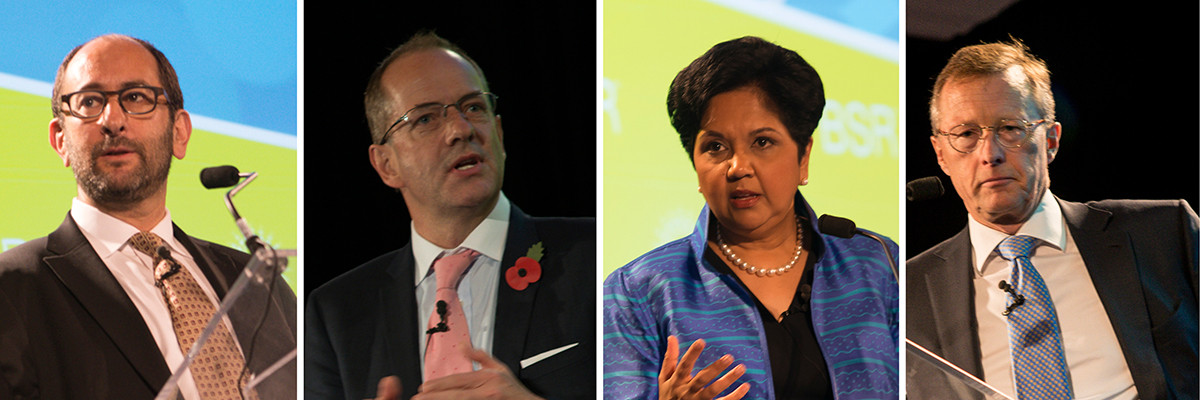
Authors
Hilary Fischer-Groban, MBA Candidate, MIT Sloan School of Management; Former Intern, BSR
“If you're going to be naked, you better get buff.” BSR President and CEO Aron Cramer quoted this aphorism from the Naked Corporation during his opening address to the BSR Conference 2014, which highlighted the event theme, “Transparency and Transformation.” The quotation echoed across the Conference, raising questions among plenary speakers and panelists such as: What does it mean to be “buff”? Now that companies are increasingly exposed, how much do they—and can they—control what to show and to whom? How are companies developing sustainability programs under public scrutiny?
These discussions centered around three approaches to transparency and transformation:
1. Look Around
Technological advancements have made the world transparent in unprecedented ways, and businesses have no choice but to transform accordingly. Previous generations were unlikely to leave their hometowns for long stretches of time. Today, we can see living conditions in the Mumbai slums, or access a live feed of Times Square at any moment.
In his plenary address, GlaxoSmithKline CEO Sir Andrew Witty reminded attendees that transparency does not refer only to Big Data, reporting standards, and disclosure requests: It has also revealed information about climate change and the exclusive nature of much of our economy. And increased transparency has created new markets, discussions, and opportunities for business leaders who are willing to open their eyes.
Witty argued that society’s historical accomplishments reflected our previously limited vision; it seemed more urgent and attainable to put a man on the moon, rather than create a malaria vaccine, simply because most of us could see the moon every single night. By contrast, the billions of people at risk of a preventable and treatable disease were not a familiar sight to many people in developed countries. Today, GlaxoSmithKline has invested more than US$350 million in malaria vaccine research, and Witty said the company would charge a deeply discounted price for the vaccine, with the 5 percent margin reinvested in research on malaria and neglected tropical diseases.
2. Think Inside the Box
Even a box can drive transformation. In his plenary address, Maersk Group CEO Nils S. Andersen surprised Conference participants by revealing the power of the humble shipping container, which has been a greater driver of globalization than all trade agreements in the past 50 years combined.
For Maersk, rapid transformation is happening by slowing things down. Andersen announced a new carbon commitment, driven by innovations in shipping speeds: By 2020, Maersk will increase its volume of goods by 80 percent while cutting absolute emissions by 40 percent by reducing the speed at which the company’s container boxes travel the world. And longer shipping times come with reduced fees, which entice customers more than the sustainability impacts. Cutting costs is the oldest business trick in the book—in this instance, thinking “inside the box” was the direct path to innovation.
3. Work It Out Together
PepsiCo Chairman and CEO Indra Nooyi reminded us that true global transformation is not the responsibility of one company, consumer, or industry; collective action is what it will take to tackle some of the world’s greatest challenges—including water scarcity, climate change, and inequality. “Ruthless collaboration,” said Nooyi, “would create a virtuous cycle with significant upside for all of society.” Collaboration is part of “Performance with Purpose,” PepsiCo’s goal to deliver top-tier financial performance while creating sustainable value for all stakeholders.
And that collaboration can be seen in PepsiCo’s work around the world and with partners in India to build recharge ponds and check dams to return more water to the community than the company uses in its operations annually.
Increased global awareness, innovation, and collaboration are essential for remaining nimble in a transparent world, and the BSR Conference 2014 was full ofexamples of companies shaping up. Next year’s examples of transformation are up to you: How will your company get fit?
For more case studies and examples on the themes of Transparency and Transformation, read the BSR Report 2013-3014.
Let’s talk about how BSR can help you to transform your business and achieve your sustainability goals.